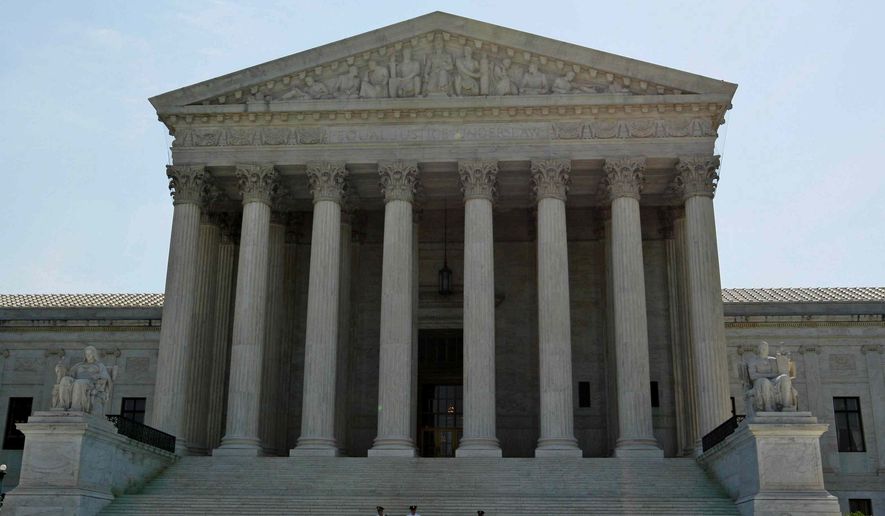The Supreme Court gave new life to affirmative action policies Thursday, upholding a Texas university’s plan that considers race as a “plus” factor in deciding whom to admit.
The justices cautioned that their 4-3 ruling shouldn’t be read too broadly, saying the University of Texas at Austin’s plan to get more minorities into school was unique and doesn’t necessarily mean other schools’ efforts would meet the same scrutiny.
Justice Anthony M. Kennedy, who wrote the majority opinion, said UT used race only as a “minor” factor, affecting just a small percentage of enrollments — though he acknowledged the tension in squaring race-based preferences with the Constitution’s vision of an equal society.
“Considerable deference is owed to a university in defining those intangible characteristics, like student body diversity, that are central to its identity and educational mission. But still, it remains an enduring challenge to our nation’s education system to reconcile the pursuit of diversity with the constitutional promise of equal treatment and dignity,” he wrote.
Despite the court’s caution about a narrow ruling, affirmative action proponents said the decision will embolden other schools that were wary after a series of court decisions on where race could be used.
Indeed, Justice Kennedy — seen as the swing vote on those rulings — sided with affirmative action opponents, and his ruling surprised legal observers. His opinion reaffirmed the court’s decadeslong precedent that there are situations where race can be considered in an effort to balance for past circumstances.
Writing a lengthy dissent, Justice Samuel A. Alito Jr. said the university was relying on “noxious racial assumptions” in deciding it needed to give minority students a leg up on others in admissions.
“What is at stake is whether university administrators may justify systematic racial discrimination simply by asserting that such discrimination is necessary to achieve ’the educational benefits of diversity,’ without explaining — much less proving — why the discrimination is needed or how the discriminatory plan is well crafted to serve its objectives,” he wrote.
The ruling is the second in the high court for Texas v. the University of Texas at Austin. In 2013, the justices ruled 7-1 that lower courts didn’t give the race-based plan enough scrutiny.
They remanded the case for more consideration, but the lower courts reached the same conclusion, landing the case back before the justices.
At oral argument in December, Justice Kennedy complained that they were essentially trying the same case again without anything new other than a more nuanced opinion from the appeals court.
He said sending the case back for more evidence makes no sense and that it’s time for the court to rule — though his opinion did sound a warning against how far schools should take race in admissions policies.
His opinion was joined by Justices Ruth Bader Ginsburg, Stephen G. Breyer and Sonia Sotomayor. Chief Justice John G. Roberts Jr. and Justices Clarence Thomas joined Justice Alito in dissent. Justice Elena Kagan recused herself.
In his ruling, Justice Kennedy said states can serve as “laboratories” to experiment with the best affirmative action policies — and even hinted that UT’s policy might someday be illegal, depending on changing circumstances.
“The university must continue to use this data to scrutinize the fairness of its admissions program; to assess whether changing demographics have undermined the need for a race-conscious policy; and to identify the effects, both positive and negative, of the affirmative-action measures it deems necessary,” he wrote.
Affirmative action opponents took heart in the narrowness of the decision but said the ruling perpetuates discrimination — only this time in favor of minorities.
“Such discrimination is untenable in our increasingly multiracial, multiethnic society — indeed, a society where individual Americans are more and more likely to be multiracial and multiethnic, and where the victims of this politically correct discrimination are more and more likely to be members of racial and ethnic minority groups,” said Roger Clegg, president of the Center for Equal Opportunity.
Last year’s oral argument was notable for an exchange between Justice Antonin Scalia, who died in February, and the university’s attorney. Scalia questioned whether it made sense to artificially boost the number of minority students at top-tier schools, depriving both the students and lower-tier schools of what may be a better educational match.
“I don’t think it stands to reason that it’s a good thing for the University of Texas to admit as many blacks as possible,” Scalia said, pointing to research submitted in the case that suggested most black scientists emerged from lower-tier schools, not top research universities such as UT Austin.
The remarks scandalized black leaders, who blasted Scalia for questioning a key tenet of civil rights-era policies.
• Stephen Dinan can be reached at sdinan@washingtontimes.com.




Please read our comment policy before commenting.